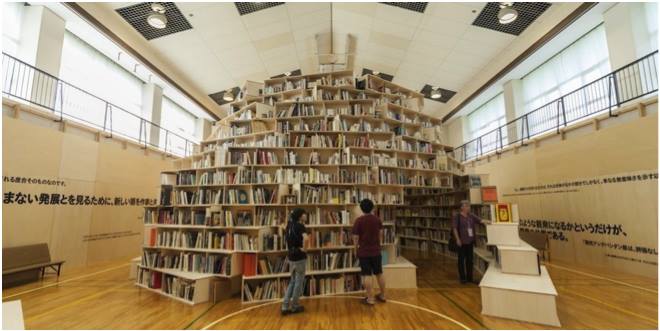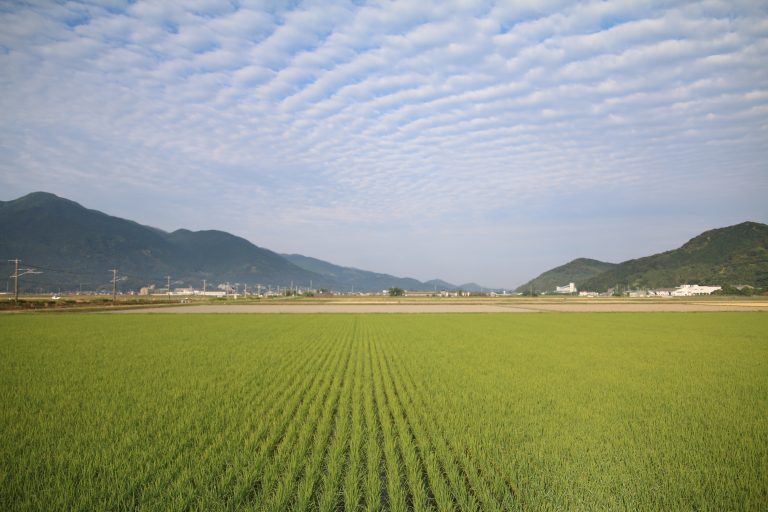Iconada.tv 愛墾 網
文化有根 創意是伴 Bridging Creativity
The power of arts projects in driving Japanese regional revitalisation By Hugh Davies
It is tricky to detect the impact Japan's 25-year recession from the lively streets of Tokyo, but the capital is a rare exception of growth in an economy otherwise in decline. Just beyond the boundary of convenience stores, pachinko parlors and fast-food outlets that describe the metropolitan edge, evidence of turn-down is everywhere. Deserted schools, derelict farms and shrines lost in bamboo overgrowth evidence the post-boom economy, but also show Japan's fading spiritual connection with nature and ancestral history.  Overgrown shrine in regional Fukuoka Image: Hugh Davies
Overgrown shrine in regional Fukuoka Image: Hugh Davies
Countering this trend is a series of arts projects aimed at regional revitalization. Though festivals, residencies, and architectural interventions; far-flung communities in collaboration with arts workers are driving cultural tourism, and ultimately the return of residents to remote areas. But what began as a series of regenerative arts projects has developed into something far more profound. With outcomes including the community recycling of abandoned infrastructure, new collaborations between locals and visitors, and radical proposals for low energy lifestyles, these creative initiatives have - in some instances - evolved into promising laboratories for imagining post-capitalist futures.
 Hiroshi Sambuichi Inujima Seirensho Art Museum, 2008 Image from: http://benesse-artsite.jp/en/art/seirensho.html
Hiroshi Sambuichi Inujima Seirensho Art Museum, 2008 Image from: http://benesse-artsite.jp/en/art/seirensho.html
Take for example the Inujima Seirensho Art Museum, a former copper refinery on the island of Inujima converted into a contemporary exhibition space powered by solar and geothermal energy, and featuring plant-based water purifying system. It’s creator Hiroshi Sambuichi is one of Japan’s stock of contemporary architects dedicated to designing living spaces in harmony with the elements.
Consider also the Zero Date Art Project, founded to rejuvenate the shrinking city of Ōdate by holding cultural events at derelict shopping arcades and in the surrounding countryside. Since its founding in 2007, Zero Date has implemented a long-term residency programme to engage visitors with local produce, culture and hot springs reinforcing the region's valuable existence beyond any economic gauge.
Also relevant are the many tree houses of Terunobu Fujimori and Takashi Kobayashi respectively. These inviting and playful structures make real the importance of experimental architecture, intimate social space and close proximity to nature.
 Terunobu Fujimori Tetsu Teahouse Source: http://mymodernmet.com/tetsu-teahouse-hokuto-japan/
Terunobu Fujimori Tetsu Teahouse Source: http://mymodernmet.com/tetsu-teahouse-hokuto-japan/
Far from new, this strain of Japanese creative practice has been gathering pace for over two decades but was completely overshadowed by the Superflat/Otaku artists of the 1990’s whose Akihabara kitsch better suited the appetite of the international art market. In contrast, the relational art practices discussed here deploy a different creative logic. Preferring locations in discarded pockets of the country, arts workers and architects have decoupled creativity from economy favoring social, environmental and reconstructive goals, activities that are increasingly couched in festival events.
 Takashi Kobayashi Nasushiobara tree house Source: http://designmadeinjapan.com/magazine/architecture/takashi-kobayash...
Takashi Kobayashi Nasushiobara tree house Source: http://designmadeinjapan.com/magazine/architecture/takashi-kobayash...
Among the most celebrated is the Setouchi Triennale. With an exhibition radius encompassing multiple volcanic islands across Japan’s Mediterraneanesque Seto region, the event's epicenter is the small island of Naoshima where numerous cultural sites can be enjoyed outside of the hectic triennial period. The project’s founding goals of “revitalizing the region sustainably through contemporary art” seem entirely obsolete from within the impressive Bennese House and Ando Museum. These site-designed structures by local “starchitech” Tadao Ando look out onto expansive sea views interrupted by lush volcanic mountains. But this present splendor obscures a darker past.
As a consequence of Japan's immensely successful post-war industry, surrounding rivers dumped megalitres of untreated sewerage, factory run-off and toxic waste into this inland sea killing swaths of plant and animal life. By the late 1980’s, sixty percent of the natural coastline was gone. Fortunes changed in 1992 following a number of small-scale art projects aimed at reviving the polluted region, activity that inspired the Benesse Corporation to purchase strips of land and mass-mobilize art as an instrument for rejuvenation. The area’s reversal out of ruin holds particular consequence following the economic crash of 2008 and Tōhoku triple disaster of 2011.
 Naoshima walkway Image: Hugh Davies
Naoshima walkway Image: Hugh Davies
Indeed the success of Naoshima has startled all concerned. Across the greater Setouchi region, young Japanese families have moved into once derelict homes converting them into guest-houses and cafes to cater to art tourists. It’s not just international visitors that are targeted. Domestic tourism is a huge industry in Japan and is deeply rooted in the culture. Yet despite its ultimate corporate backing, Noashima has upheld a small-island intimacy allowing for both Japanese and international tourists to bond over cosy galleries, bars, and baths.
A comparable event on another side of the country is Echigo-Tsumari Art Field. Established by Tokyo gallerist Fram Kitagawa at the behest of Niigata Prefecture council. The project began as a way to connect international artists with isolated communities to address social and environmental concerns. These lofty ambitions ensured a painstaking start, but resulting events have drawn hundreds of thousands of visitors to enjoy the ecological installations dotted though-out mountainous region.
 Harumi Yukutake, Restructure, 2006 Source: http://www.echigo-tsumari.jp/eng/artwork/restructure
Harumi Yukutake, Restructure, 2006 Source: http://www.echigo-tsumari.jp/eng/artwork/restructure
The Echigo-Tsumari Art Field presents an aspirational template for similar projects. It makes a powerful case for questioning existing paradigms through an intellectual engagement with knowledge, arts and nature. Set in a location renowned for its terraced rice fields and severe winter snowfall, Echigo-Tsumari embraces the Japanese axiom: “In summer, cultivate the fields; in winter, cultivate the mind.” To achieve this, artists are encouraged to present contemplative installations that highlight the landscape and culture through all five senses.
 Tadashi Kawamata Nakahara Yusuke Cosmology, 2012 http://www.echigo-tsumari.jp/eng/artwork/nakahara_yusuke_cosmology
Tadashi Kawamata Nakahara Yusuke Cosmology, 2012 http://www.echigo-tsumari.jp/eng/artwork/nakahara_yusuke_cosmology
The success, scale and funding of the Setouchi Triennale and Echigo-Tsumari can be compared with more grass-roots efforts but with similar regenerative ambitions.
 Studio Kura Image: Hugh Davies
Studio Kura Image: Hugh Davies
Studio Kura in the outskirts of Fukuoka city exemplifies this spirit. Initiated a decade ago local by artist Hirofumi Matsuzaki, the multifaceted arts project began as an extension of his family home but has grown to include several neighborhood locations. For Hirofumi, the project is life encompassing and profoundly personal. His family has lived in the area for many generations, but in his lifetime, local shops, schools, homes and farms have been closed or abandoned. The area is among the fifty-percent of Japanese municipalities the government forecasts may vanish in the coming two decades.
However, Studio Kura does much to nourish the local economy, culture and community through all-ages art classes, a biennale festival, and up to 100 visiting artists per year through a lively residency programme. More than bringing businesses to the community, the project transforms perceptions of the countryside from a cultural wasteland to a breathtaking location rich with contemporary art and cultural tradition. Studio Kura is but one of such arts residency programmes with others found in Gunma, Kyoto, Tokushima, Gifu and elsewhere.
 Studio Kura Image: Hugh Davies
Studio Kura Image: Hugh Davies
No matter the scope of these regeneration endeavors, Japan is in demographic and economic in decline. The gloomiest of estimates predict a population slump to 100 million by 2050, down from the present 125 million, although still more than neighboring South Korea, North Korea and Taiwan combined. But where political dithering has done little to address abandoned agricultural landscapes and remote industrial sites, arts programmes have transformed the regional landscape with outcomes that are both distinctively Japanese and internationally relevant. In the process, Japan is pioneering an alternative vision to the post-economic juggernaut, one that will be of future significance beyond the nation’s shores.
http://www.mot-art-museum.jp/edu/course.html
Dr Hugh Davies is an interdisciplinary artist and media researcher. His investigations explore transmedia games, Asian screen cultures and technology histories. He writes and speaks on digital culture, contemporary art and higher education. hughdavies.net
愛墾網 是文化創意人的窩;自2009年7月以來,一直在挺文化創意人和他們的創作、珍藏。As home to the cultural creative community, iconada.tv supports creators since July, 2009.
Latest Activity
Videos
-
鬼王大士爷
Added by engelbert@angku张文杰 0 Comments 83 Promotions
Blog Posts
陳明發:文創的文化要素
Posted by 馬來西亞微電影實驗室 Micro Movie Lab on February 21, 2021 at 11:00pm 7 Comments 70 Promotions
《愛懇網》17週年(2009-2026)誠意禮贈
Posted by 馬來西亞微電影實驗室 Micro Movie Lab on February 18, 2021 at 5:30pm 18 Comments 79 Promotions
柳敬亭說書
Posted by Host Studio on May 14, 2017 at 4:30pm 11 Comments 55 Promotions
Good and Fond Memories - Dedicated to all those born in 1940's, 1950's & 1960's
Posted by 用心涼Coooool on July 7, 2012 at 6:30pm 39 Comments 59 Promotions
愛墾雲端藝廊: 戀戀·文物館
Posted by 就是冷門 on August 24, 2013 at 10:00pm 86 Comments 86 Promotions
愛墾網特寫·新冠肺炎:人文景觀
Posted by 罗刹蜃楼 on April 6, 2020 at 11:30pm 40 Comments 69 Promotions
陳明發《2019新冠肺炎 觀察紀事》
Posted by 葉子正绿 on April 2, 2020 at 5:00pm 77 Comments 75 Promotions
《愛墾雲端藝廊》~~味蕾主題館
Posted by Rajang 左岸 on August 26, 2013 at 8:30am 29 Comments 67 Promotions
社會企業的定義
Posted by 來自沙巴的沙邦 on November 4, 2015 at 7:30pm 3 Comments 82 Promotions
Creative Industries Policy in Malaysia
Posted by Dokusō-tekina aidea on January 5, 2016 at 9:00pm 35 Comments 79 Promotions
© 2026 Created by 馬來西亞微電影實驗室 Micro Movie Lab.
Powered by
![]()
You need to be a member of Iconada.tv 愛墾 網 to add comments!
Join Iconada.tv 愛墾 網